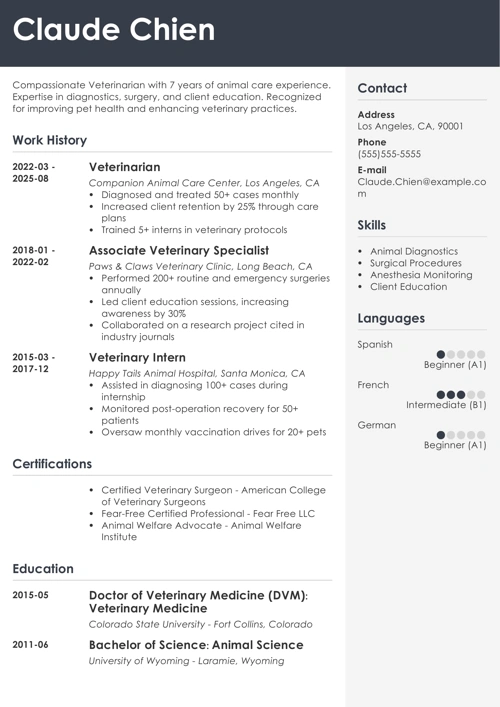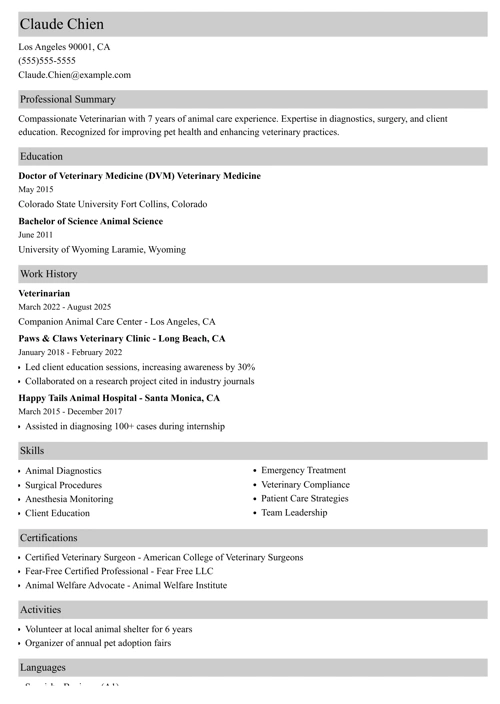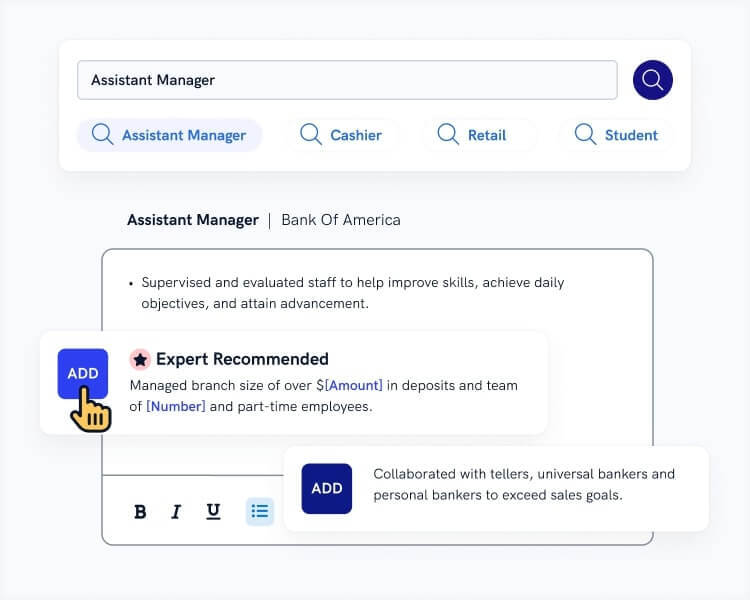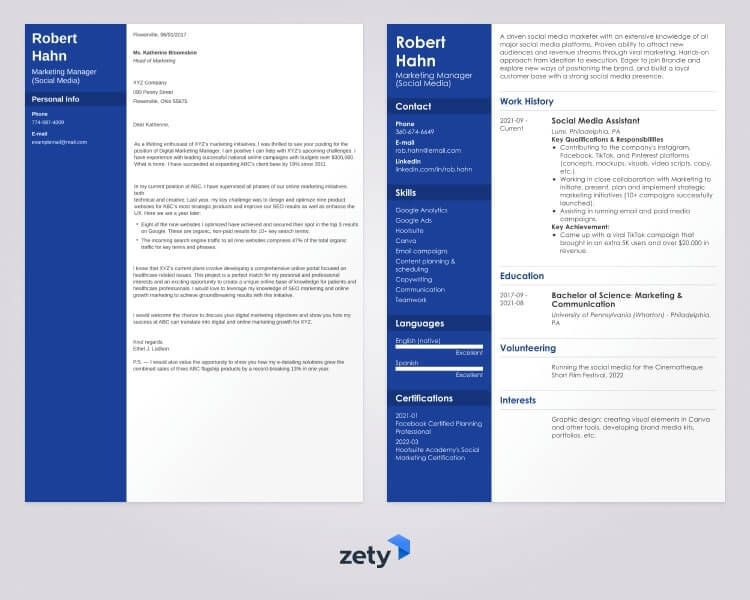You’re the best darn doggy doctor out there. You diagnose distemper and reassure worried owners with ease.
But in the dog eat dog world of vet recruiting your skills need to be definitively diagnosed. To do that you need a veterinarian resume as brilliant as the one below.
Want to save time and have your resume ready in 5 minutes? Try our resume builder. It’s fast and easy to use. Plus, you’ll get ready-made content to add with one click. Explore our free resume templates and start building your resume today.
Sample resume made with our builder—See more resume samples here.
Considering similar jobs in your industry? See these related resume guides.
- Veterinary Assistant Resume
- Veterinary Technician Resume
- Veterinary Receptionist Resume
- Lab Assistant Resume Sample
- Lab Technician Resume
- Surgical Tech Resume Sample
- Medical Assistant Resume Sample
- Medical Administrative Assistant Resume Sample
- Best Resume Example for Every Job
Sample Veterinary Resume Template
Claude Chien
claudechienzety@gmail.com
804-2860-443
Professional Summary
Associate veterinarian with 7+ years of experience. Specialist in companion animal emergency and critical care and ACVECC diplomate. Seeking to leverage my skills to contribute to high quality animal medical care in a challenging environment at Independence Animal Hospital.
Work Experience
Green Street Veterinary Clinic, Richmond, VA
Associate Veterinarian
January 2012–Present
- Experience working under pressure as sole duty vet. Treated up to 30+ patients per day. Contributed to record financial growth and productivity of the clinic.
- Worked with and assisted visiting surgeon on emergency orthopedic and soft tissue critical injury surgery.
- Held a leadership role and organized the clinic team for orderly and efficient working systems that helped create 10% increase in number of patients treated weekly without decrease in quality of care.
- Performed laboratory and surgical procedures, including spay/neuters, dental radiography and extractions, administering vaccinations and various diagnostic tests.
Education
2003–2006, BSc in General Biology
Virginia Polytechnic and State University, Blacksburg, VA
2006–2009, DVM
Virginia-Maryland College of Veterinary Medicine, Blacksburg, VA
2009-2011, Diploma in Emergency and Critical Care
ACVECC approved residency at Merrimac Animal Hospital, VA
Certification
- NAVLE
- Licensure to Practice Veterinary Medicine, Virginia
Skills
- Anesthesia
- Emergency and critical care
- Companion animal practice
- Surgical skills
- Detail-oriented
- Rational objectivity
- Ability to work under pressure
- Communication skills
Volunteering
- Volunteer consultant veterinarian at East Richmond Dog Shelter
This is how to write a job-winning veterinarian resume:
1. Use the Best Format for Your Veterinarian Resume
Veterinarians diagnose health problems in animals, prescribe medication for animal illnesses, carry out vaccinations, treat injuries, perform surgery and give owners advice. The purpose of your veterinarian resume is to show your expertise in veterinary medicine in your field of specialty.
It’s a ton of responsibilities—
And somehow, you need to communicate all of them in the seven seconds recruiters spend looking at each resume. To turn your resume into hiring manager catnip you need to follow these resume formatting rules.
- First get your resume contact information right. While you’re at it, check your online presence and carry out some LinkedIn profile surgery.
- The best format for vets is chronological resume format. There are other resume formats, but go for chronological as it puts your experience in the spotlight and it’s the one hiring managers are most familiar with. It’s also an ATS friendly resume format.
- Make use of the best resume fonts and include plenty of white space for an eyeball-friendly resume layout.
- When you save your vet resume the best resume type file is PDF so your perfect layout stays intact.
Finally, is a one or two-page resume better? If you’ve got lots of veterinary experience then two pages, even in two columns is fine. If not, then aim for a one-page resume.
Read more: Best Resume Layout Template
Now we’re all prepped, let’s start the resume surgery.
2. Write a Vet Resume Summary or Resume Objective
Wondering how to start a resume? With the right resume profile. Whether you choose tThe resume summary or theresume objective, these are different breeds of the same beast.
They’re the first section of your resume for a veterinarian and should be short and simple, 3–4 sentences. It’s what your pharma sales rep would call an elevator pitch.
If you have more than 2 years of veterinary experience use a career summary.
- First, carry out a detailed inventory of your professional experience, skills and achievements.
- Then choose 3 or 4 of the most impressive achievements from your list to include in your summary.
If you’re a new grad then go for a veterinary career objective.
- Show the veterinary knowledge you’ve learned up until now and, with passion, show how suited you are to the job.
- Think measurable details and skills you already have. Every vet school graduate has the advantage of hundreds of hours of practical experience to draw on.
And when I referred to being suited to the job and checking out the job description I didn’t just mean being a vet. You have to make it specific to each job you apply for. It’s called targeting your resume.
Now let’s perform a check-up on your work experience section.
3. Create a Best of Breed Veterinarian Resume Job Description
Your veterinary resume experience section needs to be scalpel-sharp.
- Remember the format tips? Use reverse-chronological order. Most recent job first then work back in time from there.
- Include job title, name of employer, dates of employment (using “present” as the end date if you currently work there) then write up to six job description bullet points.
- Only use the full six for your most recent positions—write less for older jobs and stick to relevant achievements only.
- How far back should a resume go? 15 years tops is a good rule of thumb.
- Start each bullet point with a resume action word to make it go off with a bang.
- Don’t just list your duties. The hiring manager knows what a vet does. To really get their attention you’ve got to include measurable professional achievements.
- Target your experience to the job description, just as you did with your professional profile.
Find out more: Work History on a Resume
4. Make Your Veterinarian Resume Education Section Shine
A vet undergoes the same rigorous education as a human MD. Arguably it’s an even more challenging discipline because your patients can’t tell you what’s wrong.
You can’t even legally practice without an education, so this section of a resume for a veterinarian has to be flawless.
- If you have more than five years veterinary experience just list your education. You need the college name, years attended, and degree with major and minors. Don’t forget to include your undergrad degree along with your DVM.
- Less than five years on the job? Your resume education section needs to highlight key wins from your college days. Make a list of relevant educational achievements and include 4–6 that match the job description.
- If you’re a new grad, then this section goes before your work experience. Early on in your career it carries more weight so make sure it gets seen first.
If you’re a fresh grad, you’re probably wondering about putting your GPA on your resume. The answer is simple. Only include it if it’s 3.5 or higher and you graduated in the last two years.
Pro Tip: Include a separate section immediately following your education for your job-specific certifications, and title it Veterinary certifications. This will include your NAVLE and any other licenses specific to your state jurisdiction.
5. Showcase Your Veterinary Skills
You’ve got one of the most skilled jobs out there. Practicing medicine on multiple species is impressive. So be sure to make this fully known on your veterinarian resume.
Here’s how—
- It’s list time again. This time create a complete catalog of all the job skills you have. Include both hard skills and soft skills, and technical skills too. Anything relevant to the veterinary profession.
- Think outside the box, too. Some skills aren’t so obvious. For one, a vet needs good communication skills to be able to work with pet owners who are in emotionally challenging situations.
- Then take another look at the job description and target your skills list to what it requires. Also, prove you’ve actually got those skills by working them into your experience and education sections.
Veterinarian Resume Skills Examples
- Animal dentistry
- Anesthesia
- Emergency and critical care
- Companion animal practice
- Equine practice
- Surgical skills
- Technical skills
- Interpersonal skills
- Organizational skills
- Problem-solving skills
- Decision-making skills
- Ability to work under pressure
- Communication skills
- Time management skills
By reviewing 11 million resumes made in our builder, we discovered that:
- Veterinarians include an average of 16 skills on their resumes.
- Among the top skills frequently listed by veterinarians are client education, vaccination administration, adaptability, animal diagnostics, and interpersonal skills.
- Veterinarians tend to create resumes spanning about 2.6 pages in length.
Making a resume with our builder is incredibly simple. Follow our step-by-step guide, use ready-made content tailored to your job and have a resume ready in minutes.
When you’re done, our AI resume builder will score your resume and our resume scanner will show you exactly how to improve it.
6. Add Extra Sections to Your Veterinarian Resume
Your veterinarian resume is in a stable condition and improving, but we’re not done with treatment just yet. Show off your unique skills with extra sections and give your resume a powerful boost.
Extra sections are particularly important for new grad vets. Without work experience you need other ways of proving you’re a great candidate. Here’s how.
- Include language skills. They’re particularly valuable in a client-facing role like veterinary practice.
- Also include projects, certifications, achievements, awards, hobbies, volunteering. Anything that’ll help you stand out for the job.
Pro Tip: Volunteering is a particularly powerful extra section. 82% of recruiters are more likely to choose a candidate with volunteering experience. For vets there are a wealth of opportunities to choose from. Just google “volunteering for veterinarians” to see what’s out there.
7. Attach a Cover Letter to Your Veterinarian Resume
Ever wondered just how important a cover letter is? Put it this way. Almost half of recruiters will reject your application if you don’t include one.
Follow these rules to write the perfect cover letter for your veterinary resume.
- Use a simple and effective cover letter format.
- Make use of a “hook” to start your cover letter.
- Stay targeted. Match your experience to the job.
- Close your cover letter by offering your expertise and with a call to action.
Then there’s that other age-old question. What’s the right cover letter length? Here’s your answer.
Correct Vet Cover Letter Length
- Half a page.
- 3–4 paragraphs.
- 200–400 words.
One more tip, always follow up on your job application. It’s often the trick to get the interview.
Plus, a great cover letter that matches your resume will give you an advantage over other candidates. You can write it in our cover letter builder here. Here's what it may look like:
See more cover letter templates and start writing.
That’s it. The prescription for veterinary resume success.
About Zety’s Editorial Process
This article has been reviewed by our editorial team to make sure it follows Zety's editorial guidelines. We’re committed to sharing our expertise and giving you trustworthy career advice tailored to your needs. High-quality content is what brings over 40 million readers to our site every year. But we don't stop there. Our team conducts original research to understand the job market better, and we pride ourselves on being quoted by top universities and prime media outlets from around the world.




